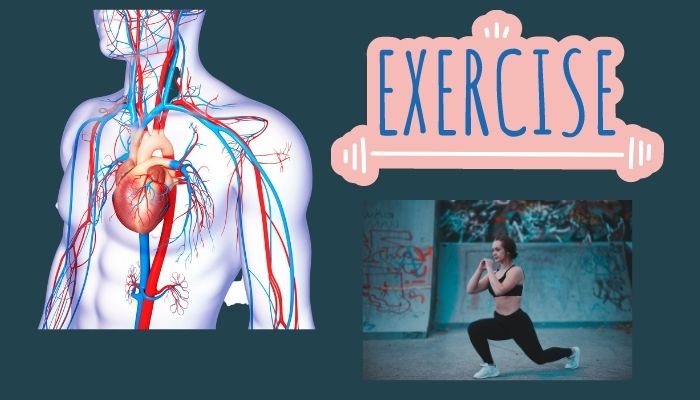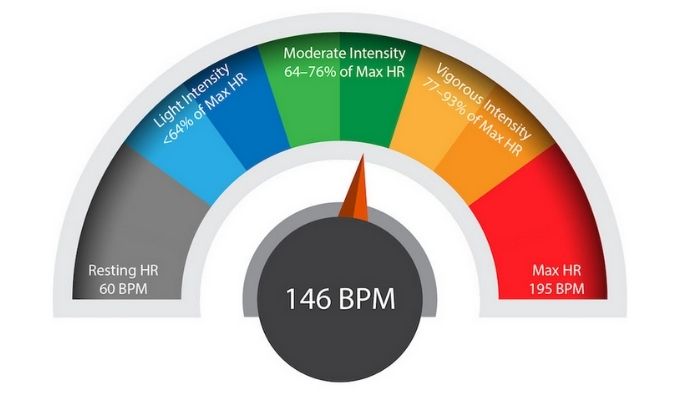When you exercise, your heart rate goes up. Your body uses oxygen to produce energy which causes your heart to beat faster. But, what is your normal heart rate when exercising?
We all know that exercise is good for us. However, did you know that there is a direct correlation between our heart rates while exercising and our risk of cardiovascular disease? In this post we will explore how measuring and knowing your heart rate when exercising can help you achieve your health and fitness goals.
We will also discuss the benefits of knowing your normal heart rate when exercising.
Normal Heart Rate When Exercising

First let’s look at your resting heart rate. The basic rule of thumb is that the lower the number, the better. For most adults, between 60 and 100 beats a minute is normal. The rate can be influenced by factors like stress, stress, hormones, medication, how physically active you are, and your menstrual cycle.
The first step is calculating your resting heart rate and to find out what your normal resting heart rate should be. This is done by taking your pulse at rest (not during exercise) and then averaging it over several days.
In order to understand your normal heart rate during exercise, you need to know, and understand two other numbers as well. These numbers include:
- Maximum heart rate by age
- Target Heart rate zones
The reason you need to understand these numbers is because your normal heart rate during exercise falls into two general categories. One is your target heart rate during moderate intensity activities and the other is your target heart rate during more vigorous activity levels.
Target Heart Rate During Moderate Intensity Activities:
Your target heart rate for moderate intensity activities can be determined by subtracting your age from 220 (220 – Age). For example, if you are a 40 year old woman, then your target heart rate would be 160 beats per minute. This number represents your maximum heart rate minus your age. If you were an 80 year old man, then his target heart rate would be 180 beats per minute. Again, this number represents his maximum heart rate minus his age.
Target Heart Rate Zones
Your target heart rate zone is simply the range of heart rate values in which you want to perform most of your physical activities. The lower end of your target heart rate zone is generally considered to be 60% of your maximum heart rate. So for example, if your maximum heart rate was 200 beats per minute, then your target heart zone would be 100-120 beats per minute. We will get into the details of this in the next section where we show you the maximum and target heart rate zones by age.
Maximum and Target Heart Rate Zones By Age

Your maximum heart rate is about 220 minus your age. For example, an 18 year old male would have a maximum heart rate of 202 beats per minute (bpm). This number represents the highest level of exertion you can sustain without reaching fatigue or exhaustion.
A person who is 50 years old has a maximum heart rate of 170 bpm. The lower your maximum heart rate, the easier it is to maintain a high level of physical activity.
A second important number is your target heart rate. If you are exercising at a moderate intensity, then your target heart rate is 50% – 70% of your maximum heart rate. If you exercise at a higher intensity, such as jogging or running, then your target heart range is 70% – 85% of your maximum heart range.
For example, let’s say that you are a 40-year-old man with a maximum heart rate of 180 bpm. You decide to begin a walking program. To keep yourself from becoming fatigued, you want to work within your target heart rate range of 90 – 126 bpm.
If you were able to walk at a pace where your heart rate was within this range, you would not experience any symptoms of over exertion. As you increase the speed of your walks, however, you may notice that your heart rate increases above your target heart rate range. At some point, you may reach a point where you cannot continue walking due to excessive fatigue.
This is why it is so important to monitor your heart rate during exercise.
To get a good idea of what your maximum and target heart rate zones are, you view an accurate chart that displays your target heart rates here.
Ways to Monitor Your Heart Rate During Exercise
Heart rate monitors are inexpensive and easy to use. They measure your pulse by detecting changes in blood flow.
You can buy a heart rate monitor at any sporting goods store, or you can use your smartphone. Some smartphones come with built-in heart rate sensors, but they do not provide enough accuracy to be used for monitoring your heart rate during exercise unless you pay extra money for a dedicated app.
There are several different types of heart rate monitors available on the market today, however, many people chose to own a fitness watch that has a good heart rate monitor associated with it. This way they do not have to have an extra fitness device to lug around with them while exercising.
There are many of these fitness watches available on the market these days. For women we recommend that you read our Garmin Vivomove HR Review here.
For men, we recommend a more masculine model, the Fitbit Charge 5 Advanced Fitness Tracker.
For the folks that do not want to use a fitness watch, we recommend a good optical heart rate sensor that straps on the arm. These types of devices are very convenient for exercise and very accurate. The one we recommend is the Polar Verity Sense Heart Rate Sensor. It is light weight, easy to read and very accurate.
Walking vs Running: What Is Better?

Running requires a lot of energy from your muscles. If you aren’t used to it, you may feel like you need to rest after a few minutes of running. However, this isn’t always true.
Running has many benefits, including burning more calories in less time. It also helps with weight loss because it burns more calories than walking.
However, running does require a bit more effort from your muscles. Therefore, if you are new to running, it might take longer before you see results.
If you are looking to get into shape, then walking is probably better suited for you. Walking doesn’t require much effort from your muscles, making it easier to start out.
You don’t have to worry about getting injured either. If you walk too fast, you could risk injuring yourself. On the other hand, if you run too fast, you could injure your knees or ankles.
Both forms of cardio are good for your overall health. They both provide an effective way to increase your metabolism and burn calories.
The best thing to remember is that no matter what form of cardio you decide to do, just make sure you stick to it!
Final Thoughts On Normal Heart Rate When Exercising
The normal resting heart rate is 60-100 beats per minute (bpm). This is the number of times your heart beats per minute while you’re sleeping. Your resting heart rate is different than your maximum heart rate. Maximum heart rate is the number of times you can beat your heart per minute during exercise.
Maximum heart rate is determined by subtracting your age from 220. So, if you’re 25 years old, your maximum heart rate would be 185. When you exercise, your heart rate increases. The higher your heart rate, the harder you work.
You can calculate your maximum heart rate by subtracting your age and dividing by 10. So, if you were 25 years old, your max heart rate would be 185 divided by 10, or 18.5 bpm.
That means that if you exercise at a pace of 18.5 bpm, you’re working hard. But if you exercise at a slower pace, you’re still working hard. You’re just working at a lower intensity.
When exercising, your goal should be to maintain a steady heartbeat between 50 and 100 bpm. That’s called moderate exercise. Exercise below 50 bpm is considered low intensity; above 100 bpm is high intensity.
How To Find Your Resting Heart Rate
To find your resting heart rate, first sit down and relax. Take a deep breath and count slowly for five seconds. Then, exhale completely and count again. Repeat this process until you reach your target resting heart rate.
Next, stand up and place your index finger on your wrist. Count how long it takes you to notice your pulse. Once you’ve counted for 30 seconds, multiply your result by 6. For example, if your resting heart rate was 80 bpm, multiply by 6 to determine your maximum heart rate.
This method will give you a general idea of your maximum heart rate. If you want to know your exact maximum heart rate, use a monitor.
Now let’s talk about those who want to lose weight. For them, they need to focus on their maximum heart rate